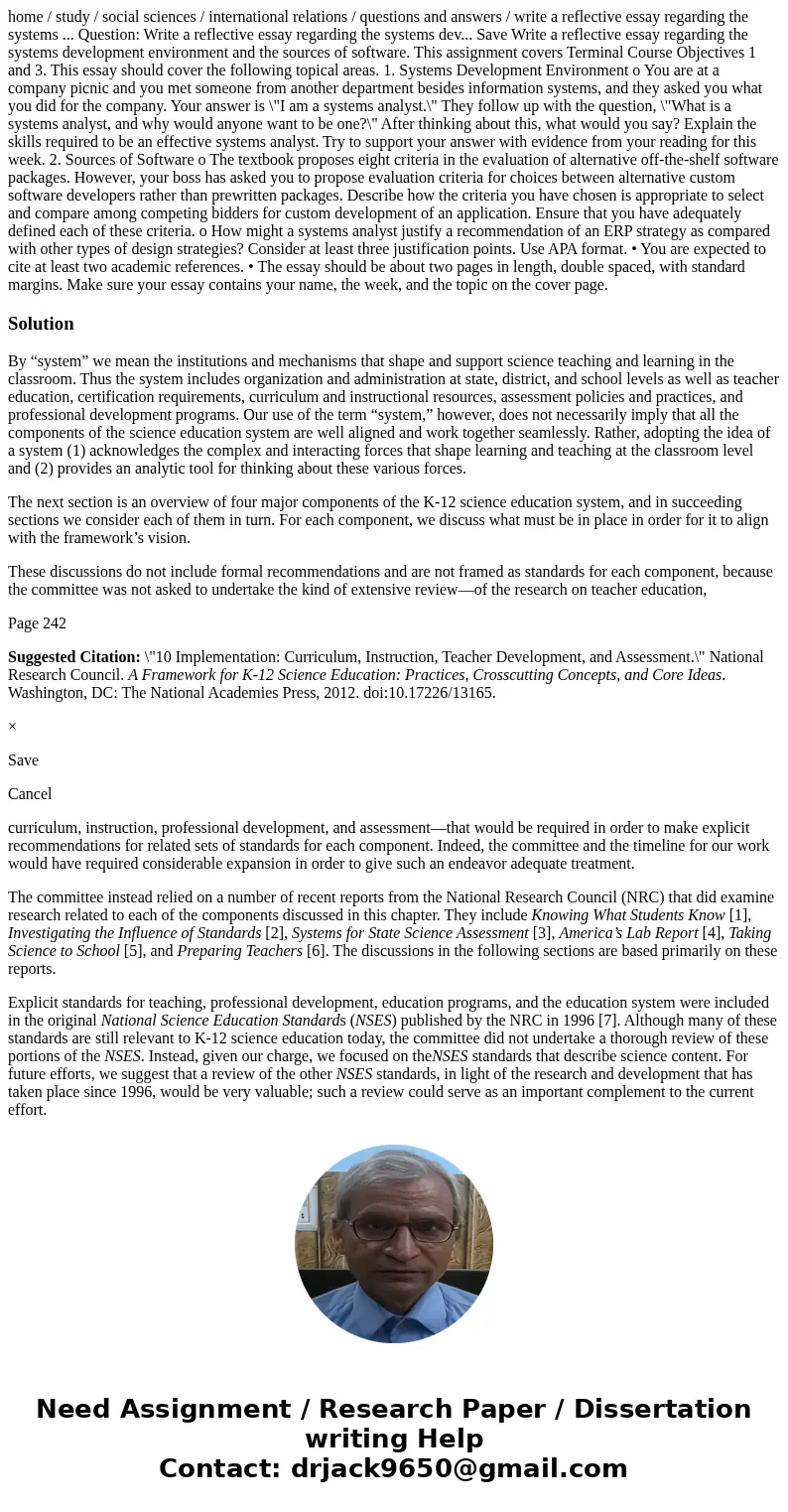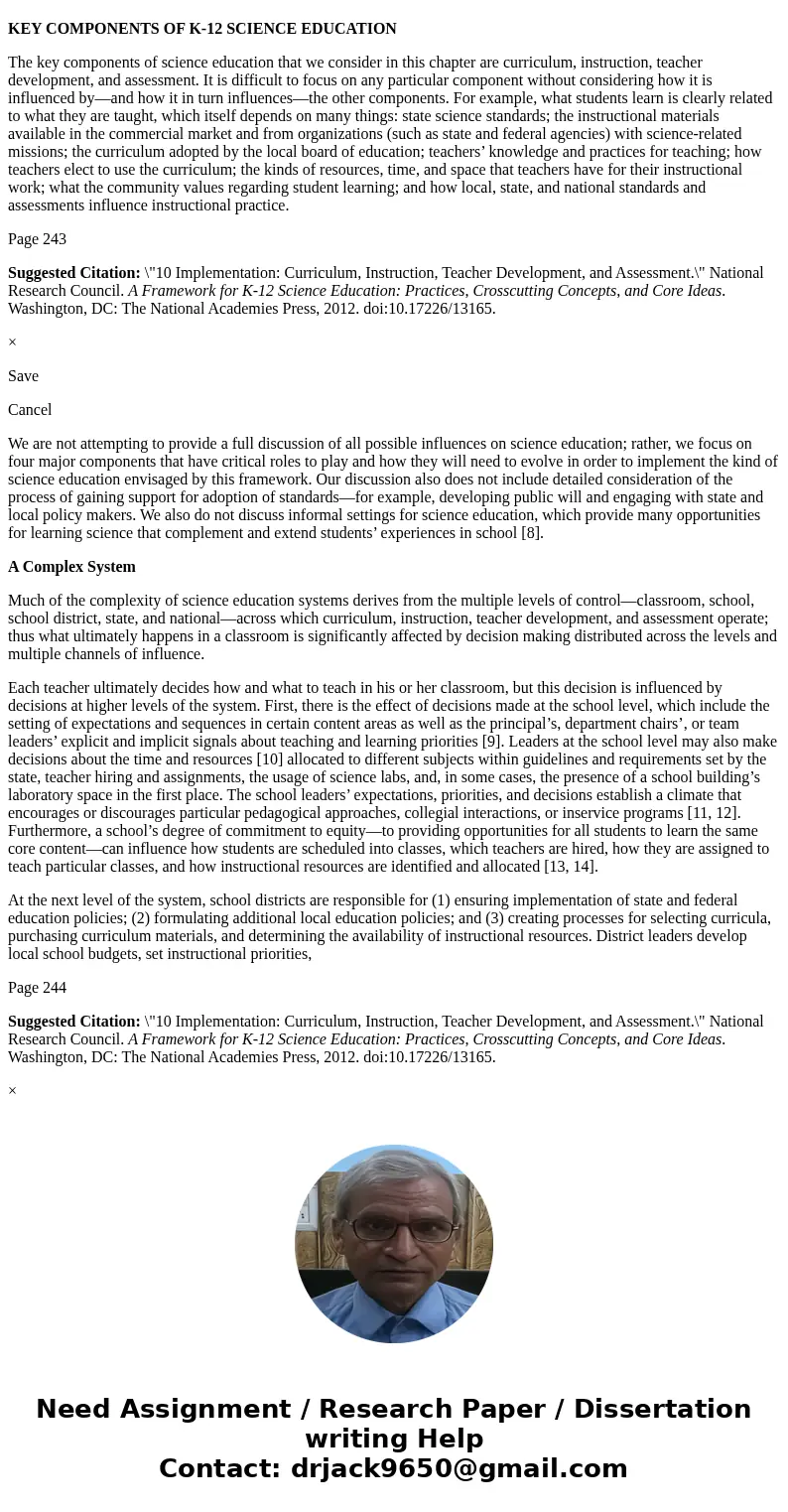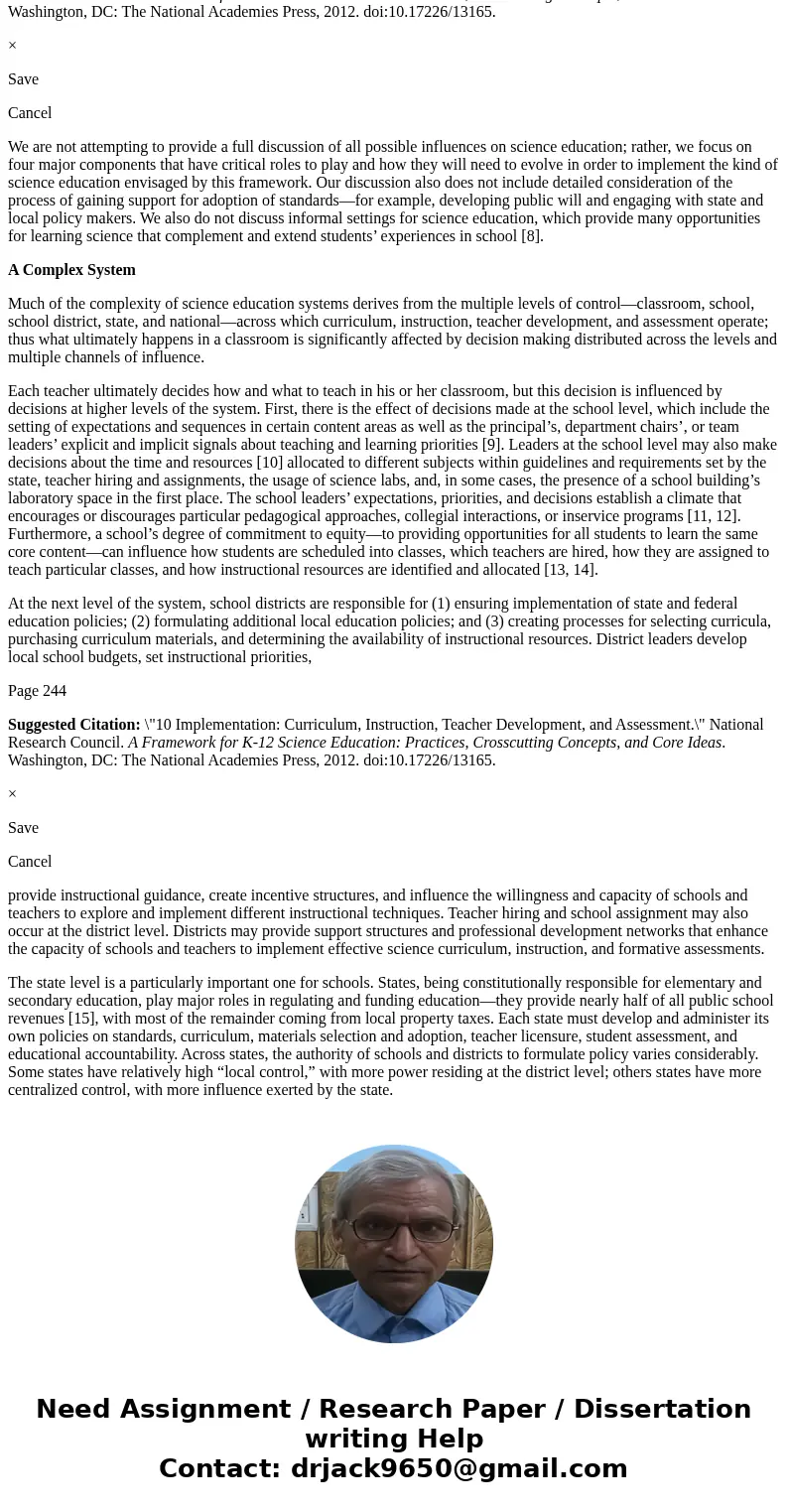home study social sciences international relations quest
home / study / social sciences / international relations / questions and answers / write a reflective essay regarding the systems ... Question: Write a reflective essay regarding the systems dev... Save Write a reflective essay regarding the systems development environment and the sources of software. This assignment covers Terminal Course Objectives 1 and 3. This essay should cover the following topical areas. 1. Systems Development Environment o You are at a company picnic and you met someone from another department besides information systems, and they asked you what you did for the company. Your answer is \"I am a systems analyst.\" They follow up with the question, \"What is a systems analyst, and why would anyone want to be one?\" After thinking about this, what would you say? Explain the skills required to be an effective systems analyst. Try to support your answer with evidence from your reading for this week. 2. Sources of Software o The textbook proposes eight criteria in the evaluation of alternative off-the-shelf software packages. However, your boss has asked you to propose evaluation criteria for choices between alternative custom software developers rather than prewritten packages. Describe how the criteria you have chosen is appropriate to select and compare among competing bidders for custom development of an application. Ensure that you have adequately defined each of these criteria. o How might a systems analyst justify a recommendation of an ERP strategy as compared with other types of design strategies? Consider at least three justification points. Use APA format. • You are expected to cite at least two academic references. • The essay should be about two pages in length, double spaced, with standard margins. Make sure your essay contains your name, the week, and the topic on the cover page.
Solution
By “system” we mean the institutions and mechanisms that shape and support science teaching and learning in the classroom. Thus the system includes organization and administration at state, district, and school levels as well as teacher education, certification requirements, curriculum and instructional resources, assessment policies and practices, and professional development programs. Our use of the term “system,” however, does not necessarily imply that all the components of the science education system are well aligned and work together seamlessly. Rather, adopting the idea of a system (1) acknowledges the complex and interacting forces that shape learning and teaching at the classroom level and (2) provides an analytic tool for thinking about these various forces.
The next section is an overview of four major components of the K-12 science education system, and in succeeding sections we consider each of them in turn. For each component, we discuss what must be in place in order for it to align with the framework’s vision.
These discussions do not include formal recommendations and are not framed as standards for each component, because the committee was not asked to undertake the kind of extensive review—of the research on teacher education,
Page 242
Suggested Citation: \"10 Implementation: Curriculum, Instruction, Teacher Development, and Assessment.\" National Research Council. A Framework for K-12 Science Education: Practices, Crosscutting Concepts, and Core Ideas. Washington, DC: The National Academies Press, 2012. doi:10.17226/13165.
×
Save
Cancel
curriculum, instruction, professional development, and assessment—that would be required in order to make explicit recommendations for related sets of standards for each component. Indeed, the committee and the timeline for our work would have required considerable expansion in order to give such an endeavor adequate treatment.
The committee instead relied on a number of recent reports from the National Research Council (NRC) that did examine research related to each of the components discussed in this chapter. They include Knowing What Students Know [1], Investigating the Influence of Standards [2], Systems for State Science Assessment [3], America’s Lab Report [4], Taking Science to School [5], and Preparing Teachers [6]. The discussions in the following sections are based primarily on these reports.
Explicit standards for teaching, professional development, education programs, and the education system were included in the original National Science Education Standards (NSES) published by the NRC in 1996 [7]. Although many of these standards are still relevant to K-12 science education today, the committee did not undertake a thorough review of these portions of the NSES. Instead, given our charge, we focused on theNSES standards that describe science content. For future efforts, we suggest that a review of the other NSES standards, in light of the research and development that has taken place since 1996, would be very valuable; such a review could serve as an important complement to the current effort.
KEY COMPONENTS OF K-12 SCIENCE EDUCATION
The key components of science education that we consider in this chapter are curriculum, instruction, teacher development, and assessment. It is difficult to focus on any particular component without considering how it is influenced by—and how it in turn influences—the other components. For example, what students learn is clearly related to what they are taught, which itself depends on many things: state science standards; the instructional materials available in the commercial market and from organizations (such as state and federal agencies) with science-related missions; the curriculum adopted by the local board of education; teachers’ knowledge and practices for teaching; how teachers elect to use the curriculum; the kinds of resources, time, and space that teachers have for their instructional work; what the community values regarding student learning; and how local, state, and national standards and assessments influence instructional practice.
Page 243
Suggested Citation: \"10 Implementation: Curriculum, Instruction, Teacher Development, and Assessment.\" National Research Council. A Framework for K-12 Science Education: Practices, Crosscutting Concepts, and Core Ideas. Washington, DC: The National Academies Press, 2012. doi:10.17226/13165.
×
Save
Cancel
We are not attempting to provide a full discussion of all possible influences on science education; rather, we focus on four major components that have critical roles to play and how they will need to evolve in order to implement the kind of science education envisaged by this framework. Our discussion also does not include detailed consideration of the process of gaining support for adoption of standards—for example, developing public will and engaging with state and local policy makers. We also do not discuss informal settings for science education, which provide many opportunities for learning science that complement and extend students’ experiences in school [8].
A Complex System
Much of the complexity of science education systems derives from the multiple levels of control—classroom, school, school district, state, and national—across which curriculum, instruction, teacher development, and assessment operate; thus what ultimately happens in a classroom is significantly affected by decision making distributed across the levels and multiple channels of influence.
Each teacher ultimately decides how and what to teach in his or her classroom, but this decision is influenced by decisions at higher levels of the system. First, there is the effect of decisions made at the school level, which include the setting of expectations and sequences in certain content areas as well as the principal’s, department chairs’, or team leaders’ explicit and implicit signals about teaching and learning priorities [9]. Leaders at the school level may also make decisions about the time and resources [10] allocated to different subjects within guidelines and requirements set by the state, teacher hiring and assignments, the usage of science labs, and, in some cases, the presence of a school building’s laboratory space in the first place. The school leaders’ expectations, priorities, and decisions establish a climate that encourages or discourages particular pedagogical approaches, collegial interactions, or inservice programs [11, 12]. Furthermore, a school’s degree of commitment to equity—to providing opportunities for all students to learn the same core content—can influence how students are scheduled into classes, which teachers are hired, how they are assigned to teach particular classes, and how instructional resources are identified and allocated [13, 14].
At the next level of the system, school districts are responsible for (1) ensuring implementation of state and federal education policies; (2) formulating additional local education policies; and (3) creating processes for selecting curricula, purchasing curriculum materials, and determining the availability of instructional resources. District leaders develop local school budgets, set instructional priorities,
Page 244
Suggested Citation: \"10 Implementation: Curriculum, Instruction, Teacher Development, and Assessment.\" National Research Council. A Framework for K-12 Science Education: Practices, Crosscutting Concepts, and Core Ideas. Washington, DC: The National Academies Press, 2012. doi:10.17226/13165.
×
Save
Cancel
provide instructional guidance, create incentive structures, and influence the willingness and capacity of schools and teachers to explore and implement different instructional techniques. Teacher hiring and school assignment may also occur at the district level. Districts may provide support structures and professional development networks that enhance the capacity of schools and teachers to implement effective science curriculum, instruction, and formative assessments.
The state level is a particularly important one for schools. States, being constitutionally responsible for elementary and secondary education, play major roles in regulating and funding education—they provide nearly half of all public school revenues [15], with most of the remainder coming from local property taxes. Each state must develop and administer its own policies on standards, curriculum, materials selection and adoption, teacher licensure, student assessment, and educational accountability. Across states, the authority of schools and districts to formulate policy varies considerably. Some states have relatively high “local control,” with more power residing at the district level; others states have more centralized control, with more influence exerted by the state.



 Homework Sourse
Homework Sourse